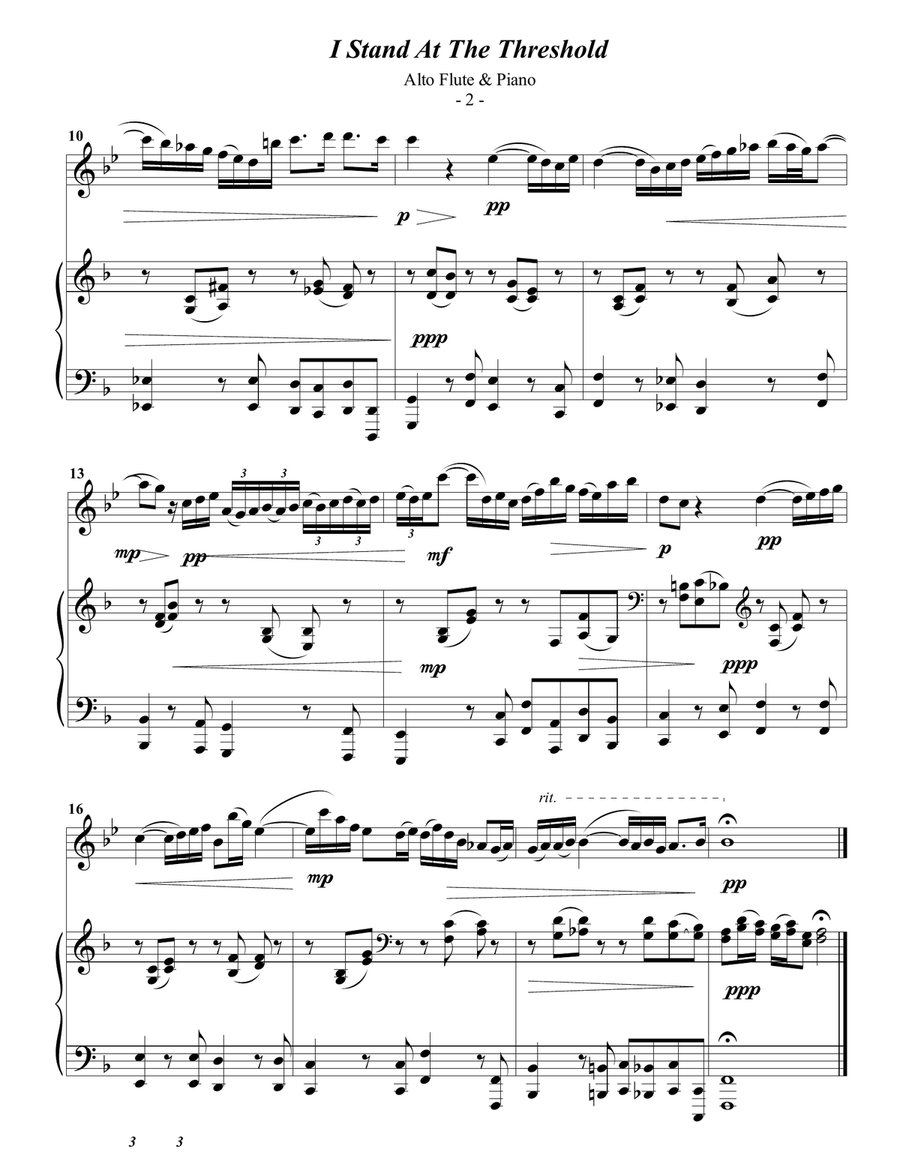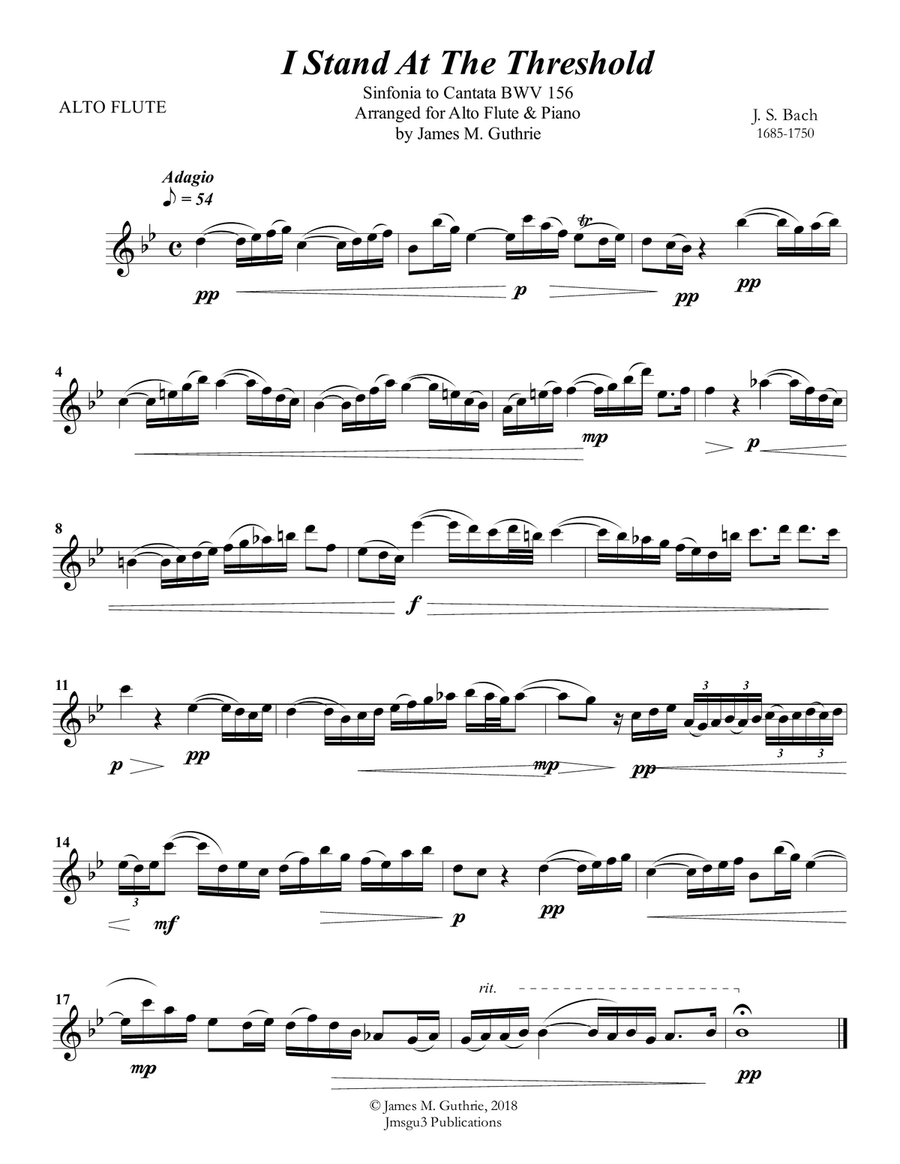Flute, Piano - Level 2 - Digital Download
SKU: A0.549130
Composed by Johann Sebastian Bach. Arranged by James M. Guthrie. This edition: audio, pdf. Baroque, Easter, Standards. Score and part. 5 pages. Jmsgu3 #3453241. Published by jmsgu3 (A0.549130).
"I Stand at the Threshold" is a popular title associated with Johann Sebastian Bach's Sinfonia from Cantata BWV 156, also known as Ich steh mit einem Fuß im Grabe ("I am standing with one foot in the grave"). This piece is often called "Arioso" and is celebrated for its deeply emotional and lyrical quality.
Key Details:
Original Context: The Sinfonia serves as the instrumental introduction to Cantata BWV 156, which was composed for the third Sunday after Epiphany. The cantata reflects themes of mortality and divine trust.
Instrumentation:
Originally written for oboe, strings, and continuo, it has since been arranged for various instruments, including piano, organ, violin, harp, and woodwind ensembles.
Mood and Style:
The piece exemplifies Bach’s ability to convey profound emotion through simplicity. It is meditative and introspective, often performed at solemn occasions. Bach's "I Stand at the Threshold," also known as the Sinfonia from Cantata BWV 156, evokes a spectrum of profound emotions in listeners. Its meditative and lyrical quality resonates deeply, often stirring feelings of:
Contemplation and Reflection:
The gentle melody invites introspection, encouraging listeners to ponder life's fragility and spiritual themes.
Melancholy and Serenity: The music conveys a bittersweet tone, blending a sense of sorrow with peaceful acceptance. Its origins are in a cantata about mortality and trust in divine providence.
Hope and Transcendence:
Despite its somber undertones, the composition also uplifts, offering solace and a sense of spiritual elevation.
Bach's masterful use of simplicity and expressive phrasing heightened these emotional responses, making the piece timelessly moving for audiences.
The melody in Bach's "I Stand at the Threshold" plays a central role in conveying the emotions of the piece, weaving together its themes of mortality, reflection, and acceptance. Several key aspects of the melody contribute to its emotional impact:
Lyrical Simplicity and Flow
The melody is gentle and flowing, characterized by smooth, descending phrases that mirror the solemnity and inevitability of life's end. This simplicity creates a meditative atmosphere, allowing listeners to connect deeply with the piece's introspective themes.
Word Painting and Textual Imagery
Bach employs melodic techniques that reflect textual imagery associated with death and the grave. For example, descending bass lines and sequences evoke the lowering of a body into the grave, while long-held notes symbolize stillness or standing at the threshold of eternity5. These elements intensify the emotional resonance by aligning musical gestures with the text's meaning.
Contrast Between Major and Minor Modes
The interplay between major and minor tonalities within the melody reflects the complexities of human emotions surrounding death—sorrowful acceptance paired with glimpses of hope and transcendence. The use of minor harmonies at cadence points adds a doleful quality, while major modes in other sections suggest optimism and divine consolation5.
Instrumental Expressiveness
The solo oboe often carries the melody, imbuing it with a plaintive yet serene character. This instrument's choice enhances feelings of introspection and calmness, emphasizing themes of compassion and acceptance.
Structural Cohesion
Bach integrates melodic ideas seamlessly with harmonic progressions and contrapuntal textures, creating a unified emotional experience. The melody’s repetitions and sequences reinforce its contemplative nature while providing stability amidst life's uncertainties2.
Through these elements, Bach’s melody becomes a vessel for profound emotional expression, capturing the sorrow and serenity of standing at life’s threshold.
This product was created by a member of ArrangeMe, Hal Leonard’s global self-publishing community of independent composers, arrangers, and songwriters. ArrangeMe allows for the publication of unique arrangements of both popular titles and original compositions from a wide variety of voices and backgrounds.
About Digital Downloads
Digital Downloads are downloadable sheet music files that can be viewed directly on your computer, tablet or mobile device. Once you download your digital sheet music, you can view and print it at home, school, or anywhere you want to make music, and you don’t have to be connected to the internet. Just purchase, download and play!
PLEASE NOTE: Your Digital Download will have a watermark at the bottom of each page that will include your name, purchase date and number of copies purchased. You are only authorized to print the number of copies that you have purchased. You may not digitally distribute or print more copies than purchased for use (i.e., you may not print or digitally distribute individual copies to friends or students).







